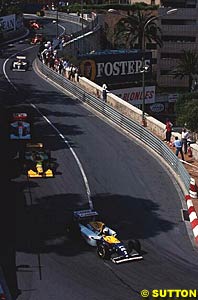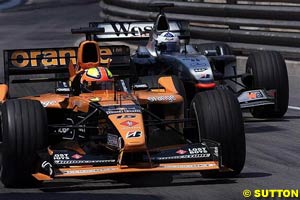
Atlas F1 Magazine Writer
What happened at the 1993 Monaco Grand Prix? Who is the favourite to win next weekend? And when are the teams likely to stop for fuel? Marcel Schot brings the answers and more anecdotes on the seventh round of 2003
While everybody was awaiting the green lights in anticipation, the Williams on pole all of a sudden made a small leap forward and quickly stopped again. The lights turned green and Prost was off like a rocket, Schumacher and Senna behind him. The race got underway with only Gerhard Berger passing Riccardo Patrese in the top eight.
Normally, this would have been more than enough for Prost to regain second place, but in a rare mistake the Frenchman stalled while serving his penalty. The team then had much trouble getting the car started again, resulting in a frustrated Alain Prost resuming the race a lap down on Schumacher and Senna and with his teammate Damon Hill closely behind him.
A few laps later Ayrton Senna decided that the gap was getting too big and with a few spectacular laps closed in on Schumacher. The young German pushed all he could, but after 33 laps it became clear that his efforts were in vain. While rounding the Loews hairpin, the Benetton erupted in dark smoke and flames as a result of a hydraulic leak that sprayed hot fluid over the engine. This of course put Ayrton Senna in the lead, with Williams driver Damon Hill a respectable 16 seconds behind him, who in turn had the Ferrari of Jean Alesi in his rear view mirror.
Meanwhile, Alain Prost had raced into the top ten again. The Williams driver was getting up to speed and passed car after car. After 39 laps he passed Erik Comas for sixth and thus made his way into the points. After that Riccardo Patrese entered the pits for a very long stop, moving Prost into fifth. The gap to Gerhard Berger in the Ferrari was big, however, so for the time being Prost's march up the field was slowed down.
With three quarters of the race gone, leader Senna pitted for new tyres, coming out on the track again with a ten-seconds lead. As the race went on, Alain Prost was falling back and was about to be lapped by Senna. The crowd waited in anticipation. By blocking his arch-enemy, Prost could serve his teammate well. However, "le professeur" was professional enough to stay out of the way and allowed Senna past and onwards to victory.
Senna was helped even more when Gerhard Berger dove past Hill into a gap that wasn't there. The Ferrari's suspension cracked on the Williams sidepod and the Austrian was out on the spot. Hill's car was in working order, but unfortunately facing the wrong way in the Loews hairpin. Luckily for Hill, he was able to spin around and resume the race before third-place Jean Alesi reached him.
With Berger out, the race ended in victory for Ayrton Senna, with Damon Hill and Jean Alesi completing the podium before a magnificent Alain Prost in fourth.
This race had everything a Monaco Grand Prix often has: drama, accidents and most importantly, unpredicatability. Ayrton Senna won for a record sixth time in a car that was by no means the fastest - a feat which Gilles Villeneuve had accomplished in 1981 and which Olivier Panis repeated in a very different way three years after Senna. In fact, in five of the last ten years, the Monaco Grand Prix was won by a driver who finished more than 20 points behind the Championship winner.
Schumacher won the race five times - in 1994, 1995, 1997, 1999 and 2001. However, with two wins in the last three Monaco Grands Prix, David Coulthard is also one to look at. The Scot will no doubt be looking to end his recent stroke of bad luck, aiming for a farewell victory for the McLaren MP4/17.
Tactically, it will be an interesting weekend. With the circuit being incredibly tight, passing has always been difficult and the grid order in Monaco is of more importance than on any other circuit. When we look at the pitstop strategies of the point-finishers last year, there are two theories: start heavy, and start very heavy. In other words, if you see an unexpected car in the front of the grid, chances are it's a publicity stunt.
Starting as heavy as possible played a large part in David Coulthard's victory, as he was able to rejoin just ahead of Michael Schumacher in the Ferrari. In the 27 laps that followed, Coulthard showed perfectly how difficult passing can be at Monaco. Schumacher was never more than a second behind, but time after time unable to dash past the McLaren.
Between his two victories, David Coulthard had a Monaco Grand Prix that was possibly one of the most frustrating races of his career. After stalling before the parade lap, the McLaren driver had to start the race from the back of the grid, where he soon met Arrows driver Enrique Bernoldi. Lap after lap Coulthard attemped to pass the Orange car in front of him, but to no avail. Even though the McLaren was clearly faster, Bernoldi was very efficient in making his Arrows as wide as possible. Only when Bernoldi pitted after 44 laps, Coulthard was able shake off the Brazilian. After that it quickly became clear how much time the experience had cost the McLaren driver; he went no less than 3.5 seconds per lap faster!
On a warm, cloudy Sunday afternoon in May 1993, twenty six engines roared low and hungry. With the Monaco Grand Prix about to start, the cars had come stationary on the grid. On pole position was Alain Prost, the French Williams driver who had returned to action after sitting out the 1992 season. Next to him was a young German called Michael Schumacher. The Benetton driver was already making a name for himself as an upcoming talent, regularly matching the performances of the fast Williamses and triple World Champion Ayrton Senna in the McLaren. The McLaren driver lined up third, with the second Williams of Damon Hill beside him.
 Alain Prost opened a small gap to Schumacher, but the German picked up the pace and steadied the gap around three seconds. However, the Benetton driver was the only one able to follow, as Ayrton Senna and the rest of the field gradually saw the two disappear in the distance. As the race progressed, Schumacher pushed Prost more and more, closing the gap to within two seconds. Then came the inevitable news of Alain Prost having to serve a ten seconds stop-and-go penalty for having jumped the start. As the leader headed into the pits, Schumacher grabbed the lead with Senna some twenty seconds behind him.
Alain Prost opened a small gap to Schumacher, but the German picked up the pace and steadied the gap around three seconds. However, the Benetton driver was the only one able to follow, as Ayrton Senna and the rest of the field gradually saw the two disappear in the distance. As the race progressed, Schumacher pushed Prost more and more, closing the gap to within two seconds. Then came the inevitable news of Alain Prost having to serve a ten seconds stop-and-go penalty for having jumped the start. As the leader headed into the pits, Schumacher grabbed the lead with Senna some twenty seconds behind him.
 When we turn the focus back to 2003, there's a sky-high favourite to win this year's race. History is again on the side of five time World Champion Michael Schumacher. Unlike the Austrian Grand Prix, which was more or less a surprise victory, the German has taken over domination at Monaco after Ayrton Senna was killed in 1994.
When we turn the focus back to 2003, there's a sky-high favourite to win this year's race. History is again on the side of five time World Champion Michael Schumacher. Unlike the Austrian Grand Prix, which was more or less a surprise victory, the German has taken over domination at Monaco after Ayrton Senna was killed in 1994.
Pos Driver Pitted in lap
==== ============== =============
1 Coulthard 51
2 M.Schumacher 44
3 R.Schumacher 50,65
4 Trulli 43
5 Fisichella 52
6 Frentzen 46,47
|
Volume 9, Issue 22
Atlas F1 Exclusive
Jos the Way It Is
Giancarlo Fisichella: Through the Visor
Articles
Remembrance of Things Past
Murphy & the Franco-American Special
Season in the Sun III
The Fuel Stop: Special Edition
Monaco GP Preview
The Monaco GP Preview
Monaco GP Facts & Stats
Columns
The F1 Trivia Quiz
Bookworm Critique
On the Road
Elsewhere in Racing
The Weekly Grapevine
> Homepage |